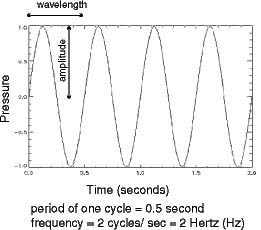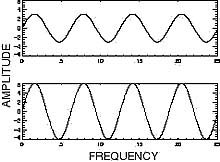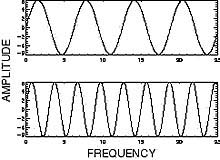
The basic components of a sound wave are frequency, wavelength and amplitude. In this example of a sound wave, the period of one cycle of this wave is 0.5 seconds, and the frequency of this wave is 2 cycles per second or 2 Hertz (Hz). Click image for larger view.
Click image to hear a scale of various frequencies (576 K, QuickTime). Click image for larger view.
Understanding Ocean Acoustics
Sharon Nieukirk, Research Assistant
Acoustic Monitoring Project
NOAA Pacific Marine Environmental Laboratory
What is Sound?
Ocean acoustics is the study of sound and its behavior in the sea. When underwater objects vibrate, they create sound-pressure waves that alternately compress and decompress the water molecules as the sound wave travels through the sea. Sound waves radiate in all directions away from the source like ripples on the surface of a pond. The compressions and decompressions associated with sound waves are detected as changes in pressure by the structures in our ears and most man-made sound receptors such as a hydrophone, or underwater microphone.
The basic components of a sound wave are frequency, wavelength and amplitude.
Frequency is the number of pressure waves that pass by a reference point per unit time and is measured in Hertz (Hz) or cycles per second. To the human ear, an increase in frequency is perceived as a higher pitched sound, while a decrease in frequency is perceived as a lower pitched sound. Humans generally hear sound waves whose frequencies are between 20 and 20,000 Hz. Below 20 Hz, sounds are referred to as infrasonic, and above 20,000 Hz as ultrasonic. The frequency of middle “C” on a piano is 246 Hz.
Wavelength is the distance between two peaks of a sound wave. It is related to frequency because the lower the frequency of the wave, the longer the wavelength.
Amplitude describes the height of the sound pressure wave or the “loudness” of a sound and is often measured using the decibel (dB) scale. Small variations in amplitude (“short” pressure waves) produce weak or quiet sounds, while large variations (“tall” pressure waves) produce strong or loud sounds.
The two examples below show sound waves that vary in frequency and amplitude.
The decibel scale is a logarithmic scale used to measure the amplitude of a sound. If the amplitude of a sound is increased in a series of equal steps, the loudness of the sound will increase in steps which are perceived as successively smaller. A decibel doesn’t really represent a unit of measure like a yard or meter, but instead a pressure value in decibels expresses a ratio between the measured pressure and a reference pressure. On the decibel scale, everything refers to power, which is amplitude squared. And just to confuse things, the reference pressure in air differs from that in water. Therefore a 150 dB sound in water is not the same as a 150 dB sound in air. So when you are describing sound waves and how they behave it is very important to know whether you are describing sound in the sea or in air.
Amplitude of Example Sounds |
In Air (dB re 20µPa @ 1m) |
In Water (dB re 1µPa @ 1m) |
| threshold of hearing | 0 dB | -- |
| whisper at 1 meter | 20 dB |
-- |
| normal conversation | 60 dB | -- |
| painful to human ear | 130 dB | -- |
| jet engine | 140 dB | -- |
| blue whale | -- | 165 dB |
| earthquake | -- | 210 dB |
| supertanker | 128 dB (example conversion) | 190 dB |
Note on Acoustic Noise Level Units: Hydrophones measure sound pressure, normally expressed in units of micropascals (µPa). Early acousticians working with sound in air, realized that human ears perceive differences in sound on a logarithmic scale, so the convention of using a relative logarithmic scale (dB) was adopted. In order to be useful, the sound levels need to be referenced to some standard pressure at a standard distance. The reference level used in air (20µPa @ 1m) was selected to match human hearing sensitivity. A different reference level is used for underwater sound (1µPa @ 1m). Because of these differences in reference standards, noise levels cited in air do NOT equal underwater levels. To compare noise levels in water to noise levels in air, one must subtract 26 dB from the noise level referenced in water. For example, a supertanker radiating noise at 190 dB (re 1µPa @ 1m) has an equivalent noise level in air of about 128 dB (re 20µPa @ 1m). These numbers are approximate, and amplitude often varies with frequency.
Faster than the Speed of Sound...
The speed of a wave is the rate at which vibrations move through the medium. Sound moves at a faster speed in water (1500 meters/sec) than in air (about 340 meters/sec) because the mechanical properties of water differ from air. Temperature also affects the speed of sound (e.g. sound travels faster in warm water than in cold water) and is very influential in some parts of the ocean. Remember that wavelength and frequency are related because the lower the frequency the longer the wavelength. More specifically, the wavelength of a sound equals the speed of sound in either air or water divided by the frequency of the wave. Therefore, a 20 Hz sound wave is 75 m long in the water (1500/20 = 75) whereas a 20 Hz sound wave in air is only 17 m long (340/20 = 17) in air.

As we descend below the surface of the sea, the speed of sound decreases with decreasing temperature. At the bottom of the thermocline, the speed of sound reaches its minimum; this is also the axis of the sound channel. Below the thermocline the temperature remains constant, but pressure increases which causes the speed of sound to increase again. Sound waves bend, or refract, towards the area of minimum sound speed. Therefore, a sound wave traveling in the sound channel bends up and down and up and down and can travel thousands of meters. Click image for larger view.
The SOFAR Channel
Sound in the sea can often be “trapped” and effectively carried very long distances by the “deep sound channel ” that exists in the ocean. This SOFAR or SOund Fixing And Ranging channel is so named because it was discovered that there was a "channel" in the deep ocean within which the acoustic energy from a small explosive charge (deployed in the water by a downed aviator) could travel over long distances. An array of hydrophones could be used to roughly locate the source of the charge thereby allowing rescue of downed pilots far out to sea. Sound, and especially low-frequency sound, can travel thousands of meters with very little loss of signal. Read more information on the SOFAR channel.
The field of ocean acoustics provides scientists with the tools needed to quantitatively describe sound in the sea. By measuring the frequency, amplitude, location and seasonality of sounds in the sea, a great deal can be learned about our oceanic environment and its inhabitants. Hydroacoustic monitoring (listening to underwater sounds) has allowed scientists to measure global warming, listen to earthquakes and the movement of magma through the sea floor during major volcanic eruptions, and to record low-frequency calls of large whales the world over. As our oceans become more noisy each year, the field of ocean acoustics will grow and only become more essential.
Sign up for the Ocean Explorer E-mail Update List.











